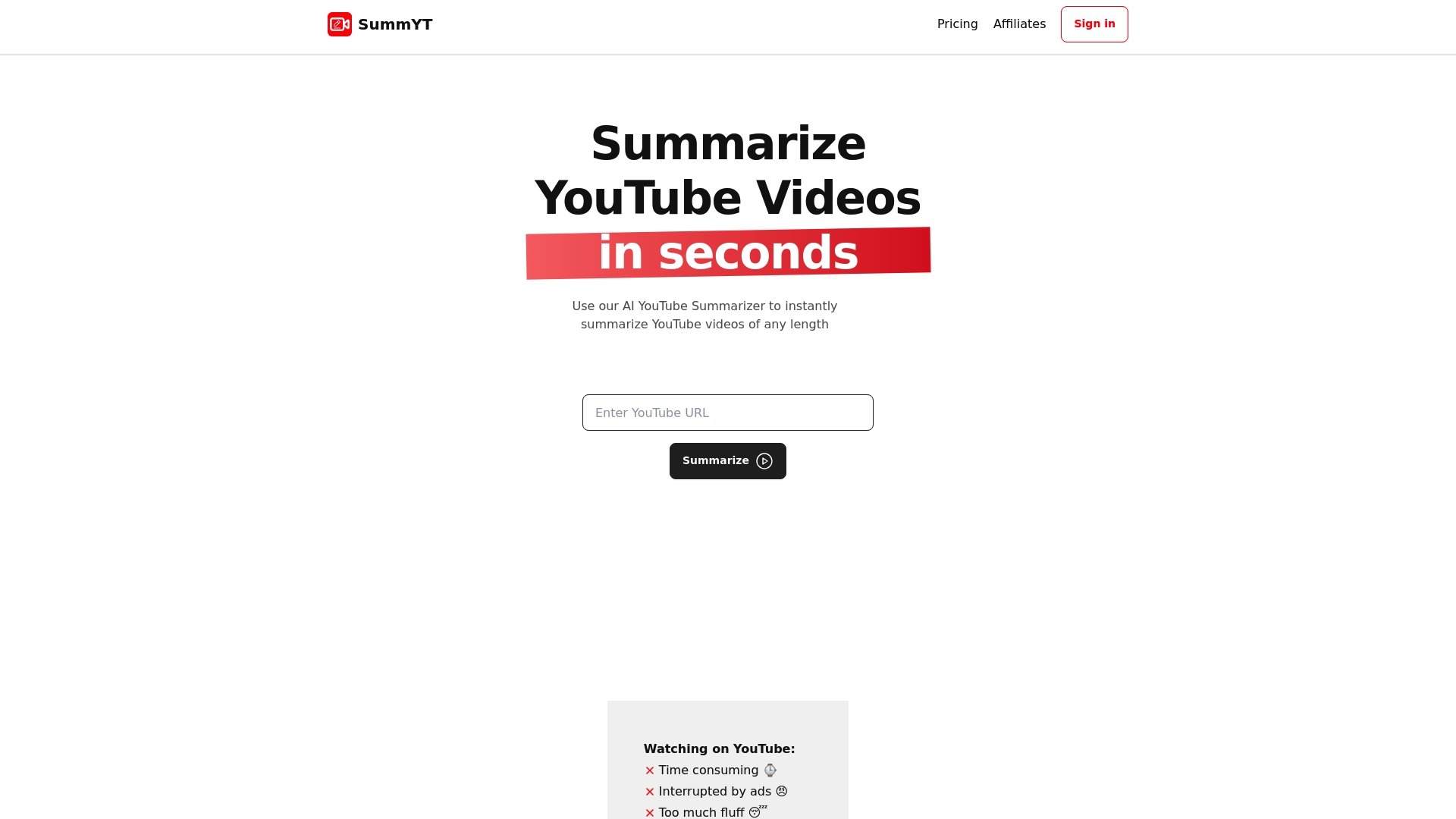Video Transcript vs Summary: Complete Guide for 2025

Did you know that video transcripts can improve content accessibility by up to 85 percent for people with hearing loss? As the amount of multimedia information grows, finding the right way to capture and share details matters more than ever. Learning the difference between transcripts and summaries helps you choose what fits your needs, whether you seek the full story or a quick overview.
Table of Contents
- Defining Video Transcripts And Summaries
- Key Differences Between Transcript And Summary
- When To Use A Transcript Or Summary
- Benefits And Limitations Of Each Approach
- How Ai Tools Streamline Video Summarization
Key Takeaways
| Point | Details |
|---|---|
| Difference in Purpose | Video transcripts provide a verbatim account of spoken content, while video summaries condense information for quicker understanding. |
| Use Cases | Transcripts are ideal for legal and academic contexts requiring accuracy, whereas summaries are suited for rapid research and knowledge transfer. |
| AI Advancements | AI tools enhance video summarization by quickly analyzing content and generating structured summaries, saving time and improving retention. |
| Balancing Comprehension | The choice between a transcript and summary hinges on the need for detailed documentation versus efficient insight delivery. |
Defining Video Transcripts and Summaries
In the digital content landscape, video transcripts and video summaries serve distinctly different purposes for capturing and communicating information. According to research from academic multimedia organizations, transcripts are comprehensive text versions of multimedia files that provide a complete verbatim record of all spoken content, capturing every word precisely as it was spoken.
Transcripts differ fundamentally from summaries in their approach and intent. While transcripts represent a word-for-word reproduction of spoken material, summaries distill the essential information into a concise, digestible format. Understanding the Benefits of Video Summarization reveals that summaries are strategically designed to help viewers quickly grasp key insights without consuming the entire original content.
Key characteristics of each format include:
Video Transcripts:
- Capture 100% of spoken dialogue
- Include speaker names and verbal fillers
- Useful for legal, medical, and academic documentation
- Provide exact quotation capabilities
- Support accessibility for hearing-impaired individuals
Video Summaries:
- Condense main points into brief overview
- Extract critical information and key insights
- Reduce time investment for content consumption
- Highlight central themes and arguments
- Make complex information quickly understandable
The primary goal of both transcripts and summaries is enhancing information accessibility, though they accomplish this through markedly different strategies. Where transcripts offer complete documentation, summaries provide strategic comprehension, allowing users to efficiently navigate increasingly complex information landscapes.
Key Differences Between Transcript and Summary
Transcripts and summaries represent two fundamentally different approaches to documenting and communicating content. According to research from transcription experts, transcripts provide a verbatim, word-for-word account of all spoken dialogue, capturing every linguistic nuance including verbal fillers, interruptions, and speaker identifications. 7 Effective Ways to Summarize Videos for Everyone highlights how this differs dramatically from summaries, which strategically distill information to its most essential components.
The structural differences between transcripts and summaries are profound. As research indicates, transcripts are chronological documents that preserve the exact sequence of spoken words, while summaries are thematically organized to prioritize key ideas and critical insights. This means transcripts offer a complete linguistic record, whereas summaries provide a strategic overview designed for rapid comprehension.
Here’s a comparison of the key differences between transcripts and summaries:
| Characteristic | Transcript | Summary |
|---|---|---|
| Format | Verbatim, word-for-word | Condensed, main points only |
| Structure | Chronological, speech sequence | Thematic, reorganized ideas |
| Level of Detail | 100% of spoken content | Essential information only |
| Ideal Use Cases | Legal, academic, accessibility | Quick research, review |
| Accessibility | Fully accessible for all users | Aids rapid comprehension |
| Limitations | Time-consuming Hard to scan |
May lose detail Risk bias |
Key distinguishing characteristics include:
Transcript Characteristics:
- Full verbatim reproduction of spoken content
- Includes every word, pause, and verbal expression
- Maintains original speech sequence
- Supports precise quotation
- Ideal for legal, academic, and research purposes
Summary Characteristics:
- Condensed representation of core content
- Eliminates redundant or tangential information
- Reorganizes content by thematic importance
- Focuses on main ideas and critical insights
- Enables quick understanding and knowledge transfer
Ultimately, the choice between a transcript and a summary depends on the specific use case.
Transcripts are essential when preserving exact language matters, while summaries excel at delivering rapid, targeted information consumption. Both serve critical roles in knowledge management, offering complementary approaches to content communication and comprehension.

When to Use a Transcript or Summary
Choosing between a transcript and a summary depends on your specific information needs and context. According to accessibility research, transcripts are critical when comprehensive documentation is required, providing a complete record of spoken content that supports diverse user requirements. Understanding the Role of Summaries in Research highlights how different scenarios demand unique approaches to content representation.
In professional and academic settings, transcripts serve specific crucial purposes. Research indicates they are essential for creating detailed records, supporting legal documentation, enabling precise quotation, and ensuring accessibility for hearing-impaired individuals. These verbatim text documents capture every linguistic nuance, making them indispensable in environments where accuracy is paramount.
Contextual scenarios for each format include:
Ideal Transcript Use Cases:
- Legal proceedings and court documentation
- Academic research and scholarly analysis
- Medical and scientific conference recordings
- Accessibility compliance for hearing-impaired audiences
- Precise historical and archival documentation
Ideal Summary Use Cases:
- Quick research and information gathering
- Professional training and knowledge transfer
- Educational content review
- Preliminary content assessment
- Time-sensitive information consumption
The fundamental decision between a transcript and summary ultimately hinges on your primary objective. When you need exhaustive detail and exact language preservation, choose a transcript. When speed, comprehension, and strategic insight matter most, a summary becomes the optimal choice. Both formats offer valuable but distinctly different approaches to capturing and communicating information.
Benefits and Limitations of Each Approach
Understanding the nuanced advantages and drawbacks of transcripts and summaries is crucial for effective information management. According to research from transcription experts, both formats offer unique benefits while presenting specific limitations that impact their utility. 7 Types of Content Summaries You Need to Know provides insights into the strategic selection of content representation methods.
Transcripts excel in providing comprehensive, verbatim documentation but come with significant time and resource investments. Research indicates that while transcripts capture every linguistic detail, they can be overwhelming for users seeking quick comprehension. Their strength lies in preserving exact language, making them invaluable for legal, academic, and accessibility purposes, but they simultaneously demand substantial time to process and analyze.
Key comparative characteristics include:
Transcript Advantages:
- 100% accurate representation of original content
- Supports precise quotation
- Enables complete accessibility
- Preserves linguistic nuances
- Ideal for official documentation
Transcript Limitations:
- Extremely time-consuming to create
- Large file sizes
- Difficult to quickly scan
- Overwhelming for casual information seekers
- Requires significant storage space
Summary Advantages:
- Rapid information consumption
- Easily digestible format
- Highlights critical insights
- Minimizes time investment
- Supports quick decision-making
Summary Limitations:
- Potential loss of contextual details
- Risk of misinterpreting original content
- Depends on summarizer’s interpretation
- Less suitable for precise academic citation
- May oversimplify complex topics
Ultimately, the choice between a transcript and summary depends on balancing comprehensiveness with efficiency. Professionals must carefully evaluate their specific information needs, considering the trade-offs between exhaustive documentation and strategic insight delivery.
How AI Tools Streamline Video Summarization
Artificial Intelligence has revolutionized the process of video content summarization, transforming how professionals and learners consume information. According to advanced technological research, AI tools can now generate structured summaries with remarkable precision and speed. 8 Examples of AI Summarization Tools You Need to Try demonstrates the cutting-edge capabilities of modern AI-driven summarization technologies.
Research indicates that AI models can handle complex content processing with unprecedented efficiency. These intelligent systems analyze video transcripts, extracting key themes, identifying critical insights, and generating concise summaries that capture the essence of lengthy presentations. By leveraging natural language processing and machine learning algorithms, AI tools can distill hours of content into focused, digestible formats within minutes.
Key advantages of AI-powered video summarization include:
Technical Capabilities:
- Rapid content analysis
- Consistent summarization quality
- Multi-language support
- Contextual understanding
- Scalable processing capabilities
Intelligent Processing Features:
- Semantic content extraction
- Thematic insight identification
- Automatic keyword recognition
- Contextual comprehension
- Nuanced language interpretation
Practical Benefits:
- Significant time savings
- Improved information retention
- Accessible knowledge transfer
- Reduced cognitive load
- Enhanced learning efficiency
The future of video content consumption lies in these intelligent summarization technologies. By transforming complex, time-consuming video materials into clear, concise summaries, AI tools are democratizing knowledge access and enabling more efficient information processing across professional and educational domains.
Save Time and Capture Key Insights with AI-Powered Video Summaries
The article highlights a common challenge: deciding when to use a full video transcript or a concise summary to best understand complex video content. Many professionals, students, and lifelong learners struggle to keep up with long lectures, webinars, and interviews where accuracy and speed both matter. You want access to every detail without spending hours, yet summaries that lose important context are frustrating. This is where the power of AI comes into play to provide clear, accurate, and time-saving summaries specifically designed to meet these needs.

Discover how SummYT bridges the gap between exhaustive transcripts and quick summaries by automatically generating easy-to-understand, precise video summaries from any YouTube video. Whether you need detailed insights for research or just want to breeze through industry talks, SummYT offers unlimited summaries that save you hours while keeping essential information intact. Start transforming your learning process now and never let long videos slow you down. Explore more at SummYT and unlock the future of efficient video comprehension today.
Frequently Asked Questions
What is the main difference between a video transcript and a video summary?
Transcripts provide a verbatim, word-for-word account of spoken dialogue, while summaries condense the main points and critical insights into a brief overview, highlighting essential information without all the details.
When should I use a video transcript instead of a video summary?
Use a video transcript when accurate, complete documentation of spoken content is required, such as in legal proceedings, academic research, or for accessibility purposes. A summary is more suitable for quick information retrieval and decision-making.
What are the benefits of using video transcripts?
Video transcripts offer 100% accurate representation of spoken content, support precise quotations, and maintain complete accessibility, making them ideal for official documentation and detailed analysis in various fields.
Can AI tools assist in creating video summaries?
Yes, AI tools use advanced algorithms to analyze video content, extract key themes, and generate structured summaries rapidly, improving efficiency and making knowledge more accessible for users.




